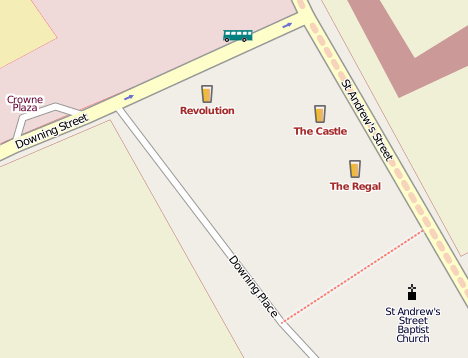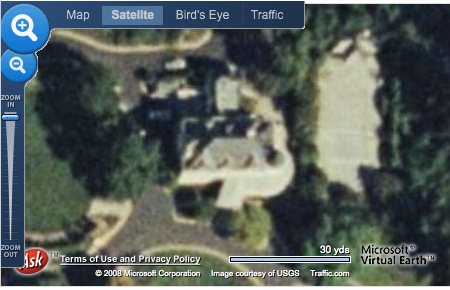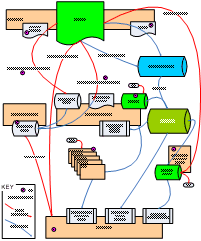In early 2006 a patriotic Palestinian uploaded a collection of placemarks to the Google Earth Community pinpointing old Arab villages that were abandoned or forcibly cleared in the upheavals that followed the establishment of Israel in 1948. The post generated much discussion and many downloads, which meant that the attached placemarks were soon visible in Google’s “Best of Google Earth Community” layer, generated automatically from an algorithm for interestingness and visible by default on Google Earth.
As a result of this promotion, patriotic Israelis discovered that one of the several hundred placemarks, which puts the alleged destroyed village of Arab Ghawarina on top of the modern Israeli town of Kiryat Yam, was in all likelihood misplaced. Not amused by having this erroneous placemark appear above Kiryat Yam, the town in question filed a legal complaint in February 2008. Media reports from the time indicated that the Palestinian author of the layer, Thameen Darby, was open to correcting the location of Arab Ghawarina, but for some reason this never happened, possibly because the entire thread was soon locked down by the forum’s moderators.
The result was a campaign by some patriotic Israeli groups to get the offending placemark removed from Google Earth. On June 2008 The Jerusalem Center for Public Affairs accused Google of anti-Israel bias for not removing user-generated content from a default layer that the center felt was slanderous:
Generally, Google allows all kinds of organizations or individuals to create overlays with their own information on its map. These overlays are only available to those who specifically request them, but they are not automatically incorporated into the core map of Google Earth that every user entering its website can see. Disturbingly, Google has incorporated the Palestinians’ overlays and their accompanying narrative into its core maps of Israel. As Google maintains editorial control over its core layer, it has responsibility for its content, which it clearly has not adequately exercised.
The main problem with the above accusation of anti-Israel bias is that content for the “Best of Google Earth Community” layer was indeed “automatically incorporated”, based on an algorithm for interestingness without further human input by Google, and that there were in fact many, many other examples where user-generated content visible by default would favor the narrative of one group over another, and be promoted to default visibility simply based on the interest it created on the forum. An O’Reilly blog uncritically repeats the report’s accusations of bias as true.
In July 2008 the Zionist Organization of America (ZOA) wrote a letter to Google CEO Eric Schmidt and in a press release “condemned” Google for knowingly permitting Google Earth to “become a vehicle for promoting false and demonizing political propaganda about Jews and Israel.” Part of the letter reads:
Google has permitted anti-Israel propaganda to be elevated on Google Earth so that it automatically appears when Google Earth users seek geographical information about Israel; other content contributed by outsiders has not been treated the same way. It is shameful to see that Google has chosen sides and is knowingly and deliberately promoting anti-Israel falsehoods.
Again, the record shows otherwise. All other content was treated the same way, and so the accusation that Google chose sides does not stand up to scrutiny.
What is true, however, is that many people assumed that being part of the “Best of Google Earth Community” layer somehow amounted to an endorsement by Google. This was not the case, though Google never made that case particularly clear. Such a lack of clarity amid a growing sense that Google Earth has become the de facto geographic gold standard allowed accusations of bias to gain currency.
Fast-forward to the present day. Log on to Google Earth as of a few weeks ago, and you will no longer find a “Best of Google Earth Community” layer. Zoom into Kiryat Yam and you will no longer find the offending placemark turned on by default. Instead, you need to go to Gallery > Google Earth Community and turn on that layer manually. Then, indeed, the placemark for Arab Ghawarina becomes visible again.
Patriotic Israelis are claiming credit for the change:
Google is no longer in the business of delegitimizing Israel because we made our voices heard. Such efforts need to continue, calling into question every bit of misinformation and outright falsehoods that are published about Israel.
Interestingly, a Jerusalem Post article from Aug 31 explicitly calls the new default “Places” layer a more robust replacement for the now-defunct default “Best of Google Earth Community” layer. Nobody at Google is quoted on the record in the article as this being the intention, though I suspect it may have been sold as such to the reporter off the record. The article also contains other information that I haven’t been able to find on the record elsewhere:
Key to the new layer are special algorithms that corroborate information received through one source with the other sources. According to a company statement, this will make “it easier for users to learn about a given place through photos, videos, and annotations contributed by users around the world.”
But it will also allow Google Earth to automatically corroborate any information received from users before displaying it on the default layer. Only information appearing in more than a single source will be displayed in this layer.
On Google Lat Long Blog, Google made no mention of such algorithms when announcing the layer a few weeks ago. I’m a bit sceptical as to their usefulness, if they exist — the Panoramio photo and Wikipedia components of the Places layer have community guidelines that discourage tendentious speech in any case, but YouTube and Google Earth Community components are more accepting of such speech. I’m not sure how a popular but tendentious georeferenced YouTube video is supposed to be filtered out by an algorithm. Time will tell if the Places layer is geobomb-able, though patriotic Israelis can at least be certain that Thameen Darby’s layer of disappeared Palestinian villages is not in any danger of popping up: the places he references no longer exist, and hence won’t be getting any Places placemarks.
Overall, I’m happy with the change. I love the Google Earth Community layer — it is my favorite because of its generous and raw overabundance of both objective and subjective information, no matter where I am on the globe or how much I’ve zoomed in. It’s best that Google makes clear it is user-generated. I see the new Places layer as user-friendly alternative to the full-blown sensory overload that can greet new users turning on all the layers.
I’m less happy with the accusations of anti-Israel bias in Google Earth, based on the default presence of the Arab Ghawarina placemark, when clearly these were unfounded. The worst that can be said about Google in this episode is that it didn’t clearly label user-generated content as such. It would be great if those groups who made the accusations would now retract them, but part of me suspects that they weren’t made in good faith on mistaken assumptions about the inner workings of Google Earth. I may be wrong.
Is this case now closed? Don’t count on it. There is a part in ZOA’s letter to Eric Schmidt that has the potential to cause many more sparks to fly:
The problem of Google Earth is immediately apparent when users “fly to” the satellite map of Israel and seek geographic information about the state. As one news report noted, users “will get much more than a geography lesson.” Google Earth users are immediately greeted with two rectangles prominently displayed on the map with the words, “Every Human Has Rights.” When users click on these rectangles, they are treated to political propaganda about the suffering of Palestinian Arabs allegedly as the result of the so-called Israeli “occupation.” Users will reasonably, but wrongly, conclude that because this information appears by default on the Google Earth map, it is accurate and reliable, when in fact, it is nothing more than politicized propaganda that conveys falsehoods to Google Earth users about Jews and Israel.
Those Every Human Has Rights placemarks are still there by default, as part of the Preview layer. One is about a grieving Israeli mother whose daughter was killed by a Palestinian suicide bomber, and the other is about a man teaching Palestinian children non-violent ways of dealing with their predicament; but both placemarks also implicitly criticize the character of the Israeli presence in the West Bank, a perspective shared by many who are not anti-Israel or anti-semitic, like myself.
What’s interesting is that this layer, produced under the aegis of The Elders and Realizing Rights, was made in collaboration with Google Outreach and its contents vetted by all three organizations. If patriotic Israelis want to pursue the matter of Google’s perceived anti-Israel bias further, this is likely to be the most promising direction for them. (Full disclosure — I was responsible for the layout and design of the popups of the Every Human Has Rights layer.)


